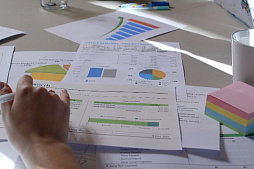After receiving the necessary documents (application form and project presentation), our team will try to review your request as soon as possible, and leading experts will offer the best options for project funding.
By combining the strengths of hydropower, wind, and solar power, we can quickly reduce dependence on fossil fuels and ensure the stability of energy sector.
In particular, wind and solar energy can be stored in pumped storage power plants and quickly released when needed.
Hydropower generates electricity all year round and has low operating costs, providing generation of affordable energy in the long term. But the construction of large hydroelectric power plants can take up to 10-15 years or more with a huge initial investment.
These projects require the rational use of all available financing mechanisms, including long-term investment loans, syndicated loans, project finance, leasing instruments, bond issues, international financial assistance, and others.
Global investment in hydropower: figures and trends
In 2022, the total installed hydropower capacity exceeded 1,200 GW for the first time.Moreover, global investment in the construction and modernization of hydroelectric power plants will increase to more than $36.3 billion. In 2021, energy companies around the world added 14 GW of installed hydropower capacity, and total energy production increased to over 4,400 TWh.
The contribution of hydropower to electricity generation is still greater than that of all other renewable energy sources combined, including wind, solar PV, geothermal energy and bioenergy.
Despite the decrease in available locations for the construction of new large hydropower plants, the hydropower sector still remains the foundation of green energy. The sector has grown rapidly over the past half century, as evidenced by the rapid growth in installed capacity from less than 700 GW in 2000 to the current 1,360 GW (including pumped storage).
The International Hydropower Association launched a new campaign in 2022 calling for more investment in the hydropower sector to fight climate change, accelerate the phase-out of fossil fuels and improve energy security.
It is clear that hydropower will become an even more important source of energy in the coming years after Russian aggression in Europe has exposed the dependence of the world's leading economies on external supplies of natural gas.
The campaign comes after world leaders pledged at COP26 to phase out carbon and accelerate the transition to renewable energy. While the Glasgow Climate Pact has been well received around the world, governments and businesses have not moved far enough in this direction. The current political situation and high hydrocarbon prices have demonstrated that commitments must be urgently translated into real investments and practical steps.
Table: Installed hydropower capacity by country (2021).
| Country | Installed capacity, GW | Country | Installed capacity, GW |
| China | 391 | India | 51 |
| Brazil | 110 | Japan | 50 |
| United States | 102 | Norway | 33 |
| Canada | 82 | Turkey | 31 |
| Russian Federation | 56 | France | 25 |
Hydropower in North America
This region is distinguished by huge water resources, which is especially true for Canada and some US states.With large investments in the hydropower sector, North America and Central America are showing significant progress in the development of green energy. Governments in these regions continue to actively support the sector.
Canada currently provides more than half of its total generation from hydroelectric power plants of various sizes, while continuing to invest in new hydropower plants (including those in Ontario and Mannitoba).
Moreover, Canada is developing power transmission projects to sell power from Quebec to the United States.
The United States, being one of the world's leaders in terms of installed hydropower capacity, still generates only 5-7% of electricity from hydropower. This is a critically small share in the context of the green transition. However, pumped storage plays an important role in regulating the American power grid. The US is also investing heavily in offshore energy.
Central and South America
The Mexican authorities are currently focusing on upgrading existing hydropower assets without being able to build large new hydropower plants.Investments in modernization include both a number of large facilities and mini hydropower plants.
However, these investments will not provide a significant increase in installed capacity in the near future.
As for Costa Rica, this country mainly relies on green energy, 75% of which is represented by HPPs. El Salvador recently completed work on the country's largest investment project, a 66-megawatt hydroelectric power plant. A high share of hydropower remains in Panama, where it accounts for more than 70% of generation. A 104 MW hydroelectric power plant was recently commissioned in Honduras, significantly increasing the share of hydropower in the energy mix.
Hydropower projects in South America are developing rapidly, making the region's installed capacity growth one of the highest in the world. Countries such as Brazil and Argentina have a lot of old large hydroelectric power plants, so the main efforts are focused on modernizing existing capacities.
New hydropower capacities are being added in Paraguay, Uruguay, Chile (Los Lagos project) and other countries in the region.
In Brazil, hydropower plants generate about half of the electricity, while in Argentina, hydropower provides about 13% of the total electricity demand. The Santa Cruz River Hydroelectric Complex, a major investment project with a high proportion of foreign capital (China), plays an important role in Argentina's energy sector.
This is a 950 MW hydroelectric power plant, the cost of which is estimated at $4.7 billion.
Investing in hydropower in Europe
In 2021, hydroelectric power plants across Europe (including the EU, UK, Turkey, Ukraine, Belarus and Moldova) produced over 660 TWh of green energy.The total installed hydropower capacity in the region is just over 255 GW. In the countries of the European Union, 37% of the total electricity production comes from HPPs. Here, this generation source plays a critical role in stabilizing the power grid, which is dependent on uneven generation from solar power plants and wind farms.
The war in Ukraine is forcing the European Union to increase investment in renewable energy sources at an accelerated pace in order to become independent of Russian gas.
The REPowerEU strategy aims to diversify hydrocarbon supplies and increase the share of green energy in the EU energy mix in the coming years.
The fastest growth in installed hydropower capacity is observed in Turkey, Norway and the Nordic countries. A recent report on the market suggests that the growth of installed hydropower capacity in Europe will reach 8% until 2030. It is clear that investment in large hydropower plants will play an important role in the energy future of the entire region.
Of the largest hydropower investments in recent years, the 1,158 MW Tamega pumped storage plant in Portugal deserves special mention.
This giant "battery", scheduled to be operational in 2023, will store up to 20 GWh of green energy, regulating the supply of power to the Porto metropolitan area.
This is one of the largest projects of this type in the European Union.
South and Central Asia
The installed hydropower capacity in the region is only about 160 GW with an annual generation of about 540 TW of energy annually.Despite the dry climate, the countries of South and Central Asia offer many suitable locations for the construction of large HPPs, which are used in India, Pakistan, Tajikistan and other countries. In particular, the total installed hydro capacity in India exceeds 51 GW with a clear upward trend. As the region's key economies look for ways to reduce dependence on hydrocarbons, the environment for hydropower investment will improve in the coming years.
An important role in hydropower here is played by small projects of mini hydroelectric power plants that supply energy to remote areas. Many communities depend on these off-grid sources of generation without a reliable connection to the national power grid.

This is especially true of the vast and sparsely populated areas in Central Asia, where small mountain rivers are the only source of life for thousands of people.
Many hydropower facilities in Kazakhstan, Uzbekistan and Kyrgyzstan are in need of modernization, as they were mostly built during Soviet times and have been underfunded over the past three decades. These countries are already taking decisive steps to upgrade and increase the installed capacity of existing HPPs to ensure long-term energy security and independence.
India has been actively financing the hydropower sector in recent years, adding predominantly medium-scale hydropower plants with an installed capacity of 50 to 300 MW.
Thus, in 2021, the country commissioned new hydroelectric power plants with a total installed capacity of about 800 MW.
Pakistan and Nepal are making great strides in this area.
The Central Asia-South Asia power project (CASA-1000) is one of the largest investments in this region in the last few years. This is a powerful hydroelectric power station being built jointly by Kyrgyzstan, Tajikistan, Afghanistan and Pakistan.
Planned in 2016, the investment project worth more than $1.15 billion is scheduled to launch in 2023.
East Asia, Australia and Pacific
The installed hydropower capacity in the region exceeds 520 GW with an annual generation of more than 1,600 TW of energy annually.The region's leaders in hydropower are China (391 GW), Japan (50 GW) and Vietnam (17 GW), followed by Laos, Australia, Indonesia, South Korea, New Zealand, and Malaysia by a significant margin. Virtually all the major hydroelectric power plants are located in China, and the country is to remain the industry leader in the coming years.
China has enormous potential for the development of the sector, showing a 20 GW increase in installed capacity in 2021 thanks to the consistent policy of investing in renewable energy. In fact, China remains the world's leading hydropower player. The government intends to consolidate this status in the coming decade.
One of the most ambitious plans of the National Energy Administration (NEA) involves a sharp increase in investment in pumped storage capacity.
According to the agency's plans, by 2030, China will account for 3/4 of the total global pumped storage capacity.
China is currently building the world's largest pumped storage power station, the Fengning Pumped Storage Power Station, which is scheduled to become operational in 2023. This facility, which holds nearly 49 million cubic meters of water in its upper reservoir, will have an installed capacity of 3.6 GW. The $1.9 billion project has been under construction since 2013.
Baihetan Hydropower Project, one of the largest hydroelectric plants, continued to be commissioned during 2021-2022. The total installed capacity of this giant facility reaches 16 GW, which makes it possible to generate about 62 TW of electricity annually.
These large investments have allowed China to add about 20.8 GW of installed capacity in 2021.
Our investment services in hydropower sector
The construction of new dams, hydroelectric power plants and electricity transmission infrastructure will require huge additional investments in the coming years.The need for long-term capital for the development of this sector is growing in the EU, Great Britain, Canada, the United States, Latin America, South and East Asia, Africa and other regions of the world.
The main sources of financing for hydropower projects include long-term loans (including syndicated loans), multilateral project finance schemes, leasing instruments, bond issues, and others.
ESFC Investment Group offers long-term financing for the construction and modernization of hydroelectric power plants. Together with our international financial partners, we are ready to develop a customized investment solution adapted to your project.
For more information please contact us.




























